The Ovcharkas -
What
Are They?
Alisa's puppies (born on January 23,
2004).
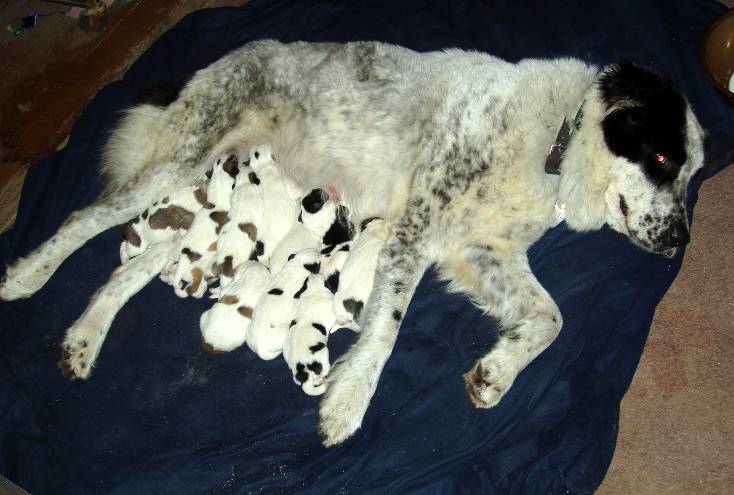
D.N. Rassokhin
Contents
- Introduction
- Origin
- Physical Characteristics
- Behavior
- Assorted Photos
- Clubs and Breeders in the US
- [NEW!] English-Russian
Dictionary of Dog Terms
Introduction
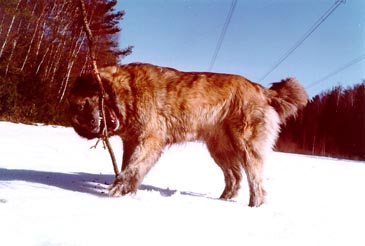 The word "ovcharka" (often spelled "ovtcharka", or
"owtcharka"; pronounced "uhf-'chAr-ka") is a Russian word meaning
something between "livestock guardian dog", "shepherd's dog" and
"sheepdog". In the Russian language "ovcharka" is used as a suffix in
the names of many working breeds, including those that are not native
to Russia, such as the German Shepherd Dog (nemetskaya ovcharka),
Belgian Sheepdog (bel'giyskaya ovcharka), and many others. This may be
somewhat confusing to a non-Russian reading Russian publications on
dog breeds. The Ovcharkas native to Russia and/or the countries of the
former Soviet Union include the following four breeds: the Caucasian
Ovcharka (also known as: Kavkazskaya Ovcharka; Caucasian Shepherd or
Sheepdog), Central Asian Ovcharka (other names include:
Sredneaziatskaya Ovcharka; Central Asiatic Ovcharka; Central Asia
Shepherd Dog; Middle Asian Ovcharka; Mid-Asiatic Sheepdog), South
Russian Ovcharka (also referred to as Youzhnorusskaya Ovcharka or
South Russian Sheepdog), and the East European Ovcharka.
The word "ovcharka" (often spelled "ovtcharka", or
"owtcharka"; pronounced "uhf-'chAr-ka") is a Russian word meaning
something between "livestock guardian dog", "shepherd's dog" and
"sheepdog". In the Russian language "ovcharka" is used as a suffix in
the names of many working breeds, including those that are not native
to Russia, such as the German Shepherd Dog (nemetskaya ovcharka),
Belgian Sheepdog (bel'giyskaya ovcharka), and many others. This may be
somewhat confusing to a non-Russian reading Russian publications on
dog breeds. The Ovcharkas native to Russia and/or the countries of the
former Soviet Union include the following four breeds: the Caucasian
Ovcharka (also known as: Kavkazskaya Ovcharka; Caucasian Shepherd or
Sheepdog), Central Asian Ovcharka (other names include:
Sredneaziatskaya Ovcharka; Central Asiatic Ovcharka; Central Asia
Shepherd Dog; Middle Asian Ovcharka; Mid-Asiatic Sheepdog), South
Russian Ovcharka (also referred to as Youzhnorusskaya Ovcharka or
South Russian Sheepdog), and the East European Ovcharka.
Origin
The Caucasian and Central Asian Ovcharkas are ancient breeds
belonging to the Asiatic type of dogs akin to the Tibetan
Mastiff. Both breeds were originally bred by the shepherds for the
protection of their livestock against large predators, such as wolves
and leopards. The Caucasian Ovcharka comes from the Caucasus (both its
mountain area, and the adjacent plains), which is the territory of the
following modern states: Armenia, Azerbaijan, Georgia, and Russia. The
Central Asian Ovcharka originated in Central Asia, the huge region
stretching from Caspian Sea in the west to the Pamirs in the east, and
from the border between Russia and Iran and Afghanistan in the south
to South Siberia in the north. Six modern countries - Kazakhstan,
Kirghizstan, Uzbekistan, Tajikistan, Turkmenistan, and Russia -
currently share that territory.
The ancestors of the South Russian Ovcharka arrived in the steppe
regions of South Russia, the Crimea plains, with the flocks of Merino
sheep from Spain in the 18th century. Those relatively small
sheepdogs soon drew the attention of the local shepherds. However,
despite the dogs' outstanding ability to herd the flocks, they
had a weak constitution making them vulnerable to predators, such as
the steppe wolf, and the severe Russian climate. Yet, the steppe wolf
was not so dangerous after all; most importantly, the local landowners
wanted the dog to be able to protect their flocks, property and the
game on their land against the much more serious threat of the Crimea
Tartar thieves and poachers, who usually made their raids mounted. The
canine newcomers from Spain were mixed with the Deerhound, Irish
Wolfhound, and the dogs of the Tibetan origin. This crossing resulted
in the large, rapid and agile dog that excelled in two different jobs:
it could both help the shepherds to herd the flocks, and guard the
livestock, property and game against the predators, thieves and
poachers, even from the horsemen.
The Caucasian, Central Asian, and South Russian Ovcharkas were
later bred and perfected in the Soviet Union in the state-run kennels
for the needs of the Army and the police, as well as the plant and
warehouse security and livestock protection work. All efforts have
been made to preserve the outstanding working abilities, strength and
beauty of these breeds.
Unlike the Caucasian, Central Asian and South Russian Ovcharkas,
the East European Ovcharka is a relatively young breed. Its direct
ancestor was the German Shepherd Dog, which was introduced in Russia
in 1904. In 1924 the German Shepherd Dog was chosen to become the main
service breed in the Soviet Union for the needs of the Red Army and
Stalin's Gulag, to guard millions of people sent to Siberian prison
camps. However, the German Shepherd Dog of the original type did not
fully match the Army and Gulag's requirements. Dogs with greater
stamina, resistance to cold weather, stronger bite and better ability
to fight people were needed. The careful breeding program was
successful and resulted in the breed later called the East European
Ovcharka. Although this breed remains one of the most popular working
breeds in its native land, it is still not widely recognized outside
Russia and often not distinguished from the "overgrown" German
Shepherd Dog. Unfortunately, at the present time, no official standard
exists for this breed; nor are carefully planned breeding programs
followed by the clubs and breeding kennels, so the future of the East
European Ovcharka is uncertain.
Physical characteristics
The Ovcharkas are powerful dogs of large or giant size. The
Caucasian and Central Asian Ovcharkas have a powerful bone structure
and a massive head. Compared to the first two Ovcharkas, the South
Russian Ovcharka has a lighter build and is a little leggier. When
shorn of its wool, it looks remarkably similar to the Doberman
Pincher. The East European Ovcharka has sturdy, muscular, slightly
elongated body with a solid bone structure.
| Breed |
Height in withers (in) |
Weight (lb.)** |
| Dogs |
Bitches |
Dogs |
Bitches |
| Caucasian |
>25.6* |
>24.4* |
132-198 |
88-143 |
| Central Asian |
>25.6* |
>23.6* |
121-176 |
88-143 |
| South Russian |
>25.6* |
>22.8* |
88-132 |
77-99 |
| East European*** |
26.3-27.6 |
23.6-25.6 |
90-154 |
80-120 |
*Lower limit. Upper limit is not set by the
standard.
**Approximate figures. Weight is not set by the standards.
***At present time, there is no official standard for this breed. |
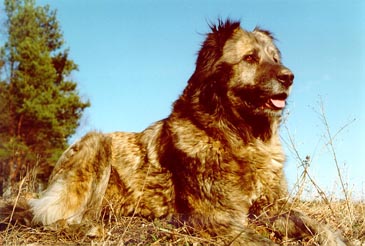 |
The Caucasian Ovcharka has a long or medium-length coat with
a well- developed undercoat. The most typical color is agouti gray.
Other colors are allowed, except for red-and-white, solid black, black-
and-tan, and solid brown. Ears are cropped short, and this, along with
long fur on the sides of its head, gives the dog a bear-like appearance. |
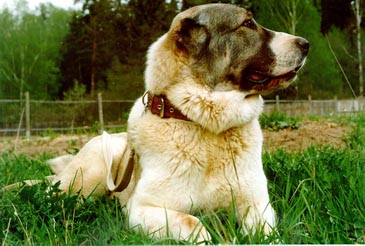 |
The Central Asian Ovcharka has a short, dense, close- lying
coat with well-developed undercoat; it is said that burrs do not stick
to it. White, black, gray, fawn, reddish fawn and brindle colors are
most common. Its ears are usually cropped, and the tail is docked. |
The South Russian Ovcharka is covered with a very long, dense and
slightly wavy double coat, which should be white or cream. Its ears
are small and covered with long fur.
The East European Ovcharka
has a short, close-lying and very dense double coat, which is black,
black-and-tan, gray, or fawn, with no white spots allowed. Completely
white color is permissible. Its ears are erect and set high.
Behavior
All the Ovcharkas are well-balanced and even-tempered, suspicious
of and aggressive toward strangers. However, the temperaments of these
four breeds have a lot of features that make these breeds remarkably
different from each other.
As already noted, the Caucasian and Central Asian Ovcharkas were
bred to protect the livestock from large predators, often with no
man's assistance, rather than to herd the flocks under the supervision
of the shepherd. (Read
this real-life story!) This work made them
very intelligent (as it comes to problem solving and making decisions)
and, at the same time, very independent and strong-willed; they (esp.,
the Caucasians) are not easily trained for obedience. Typical of these
two breeds is a somewhat low activity level with an ability to
instantly "explode" in the minutes of danger. Such a dog can look like
a large phlegmatic lazybones to an intruder, until he comes too close
to the dog and it's too late to run away. This interesting feature
stems from the fact that more active dogs with higher "energy
consumption rate" would not have survived in the conditions of the
harsh weather, hard work and scarce feeding, under which these breeds
developed.
The East European Ovcharka's personality originates from its past
as a herding dog: it is very intelligent, obedient and easily
trained. As a guard dog, it can display its fine reflexes,
lightning-quick attack and an ability to differentiate between "good"
and "bad" guys.
The South Russian Ovcharka's personality combines the features of
both a livestock guardian, and a herding dog. The experts say that
South Russians are similar to Dobermans not only in their build, but
also in the temperament: it is very intelligent, energetic and
impetuous. Being more submissive to its master than the Caucasian and
Central Asian Ovcharkas, the South Russians still sometimes display
too high aggressiveness toward other animals and people, which the
owner should be prepared to deal with.
Assorted pictures of Alisa
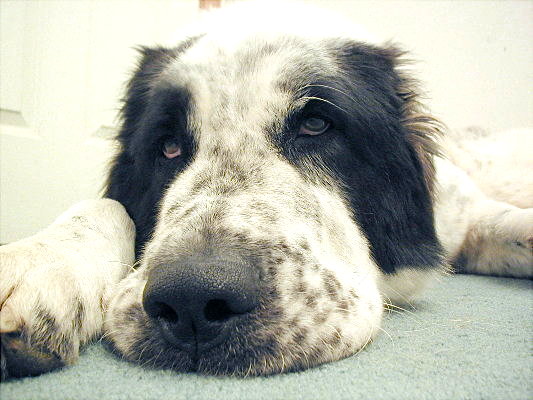
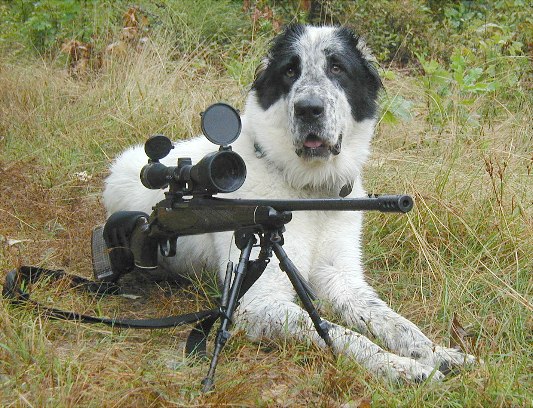
Alisa would make an excellent hunting dog for big game; unfortunately,
hunting big game with dogs is illegal in Pennsylvania, so I can only
take Alisa with me when hunting squirrels and coyotes.
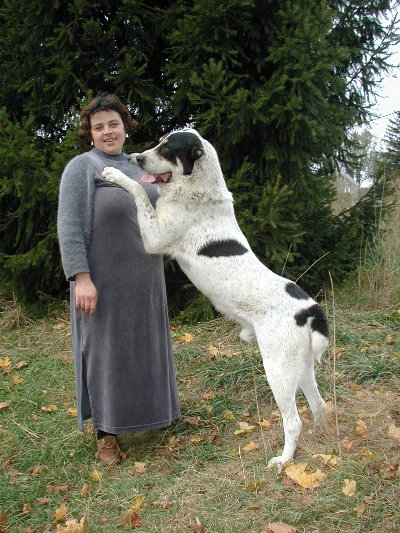
My Central Asian Ovcharka Alisa RUSDOG was bred by Anna
Frumina. Need more info? Visit this site again, I am going to update
Anna's contact info soon. You can also send me an email (see contact
info below).
All pictures in this site are digitally watermarked
and some of them are copyrighted by Webster Publishing. If you want to
use any, ask me first!
(C) Dmitrii N. Rassokhin [Email] | This text is a part of Dmitrii Rassokhin's website.
|
Last modified: July 26, 2004
 The word "ovcharka" (often spelled "ovtcharka", or
"owtcharka"; pronounced "uhf-'chAr-ka") is a Russian word meaning
something between "livestock guardian dog", "shepherd's dog" and
"sheepdog". In the Russian language "ovcharka" is used as a suffix in
the names of many working breeds, including those that are not native
to Russia, such as the German Shepherd Dog (nemetskaya ovcharka),
Belgian Sheepdog (bel'giyskaya ovcharka), and many others. This may be
somewhat confusing to a non-Russian reading Russian publications on
dog breeds. The Ovcharkas native to Russia and/or the countries of the
former Soviet Union include the following four breeds: the Caucasian
Ovcharka (also known as: Kavkazskaya Ovcharka; Caucasian Shepherd or
Sheepdog), Central Asian Ovcharka (other names include:
Sredneaziatskaya Ovcharka; Central Asiatic Ovcharka; Central Asia
Shepherd Dog; Middle Asian Ovcharka; Mid-Asiatic Sheepdog), South
Russian Ovcharka (also referred to as Youzhnorusskaya Ovcharka or
South Russian Sheepdog), and the East European Ovcharka.
The word "ovcharka" (often spelled "ovtcharka", or
"owtcharka"; pronounced "uhf-'chAr-ka") is a Russian word meaning
something between "livestock guardian dog", "shepherd's dog" and
"sheepdog". In the Russian language "ovcharka" is used as a suffix in
the names of many working breeds, including those that are not native
to Russia, such as the German Shepherd Dog (nemetskaya ovcharka),
Belgian Sheepdog (bel'giyskaya ovcharka), and many others. This may be
somewhat confusing to a non-Russian reading Russian publications on
dog breeds. The Ovcharkas native to Russia and/or the countries of the
former Soviet Union include the following four breeds: the Caucasian
Ovcharka (also known as: Kavkazskaya Ovcharka; Caucasian Shepherd or
Sheepdog), Central Asian Ovcharka (other names include:
Sredneaziatskaya Ovcharka; Central Asiatic Ovcharka; Central Asia
Shepherd Dog; Middle Asian Ovcharka; Mid-Asiatic Sheepdog), South
Russian Ovcharka (also referred to as Youzhnorusskaya Ovcharka or
South Russian Sheepdog), and the East European Ovcharka. 




